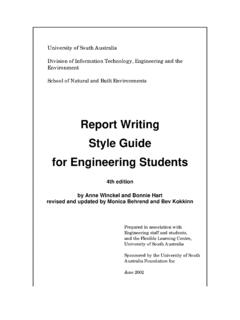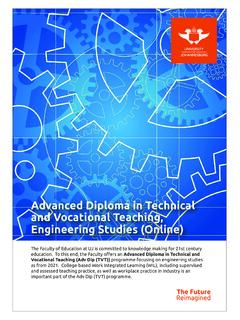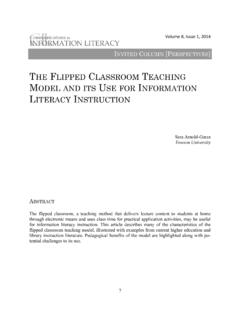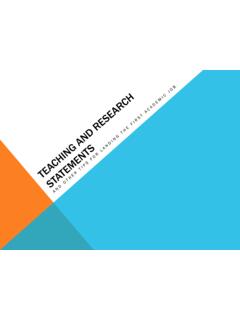Transcription of Students’ learning style and its effect on blended ...
1 International Journal of Evaluation and Research in Education (IJERE) Vol. 9, No. 1, March 2020, pp. 195~202 ISSN: 2252-8822, DOI: 195 Journal homepage: Students learning style and its effect on blended learning , does it matter? Nurasma Shamsuddin1, Jasber Kaur2 1 Faculty of Computing and Informatics, Multimedia University-MMU Cyberjaya, Malaysia 2 Faculty of Computer and Mathematical Sciences, Universiti Teknologi Mara, Malaysia Article Info ABSTRACT Article history: Received Dec 3, 2019 Revised Feb 5, 2020 Accepted Feb 24, 2020 blended learning is an approach in education system that provides multi delivery mode to optimize learning outcome and cost of program delivery in institutions.
2 Little is known on how impactful blended learning in terms of achieving the desired learning outcome. This is because students learning style has influenced their achievement and if mediated in a hybrid learning environment like blended learning will further result in evaluation and performance of blended learning environment. This study aims to investigate learning styles among the students and their relationship with perceptions of blended learning . The study involved 119 students taking the course of Diploma in Information Technology at a private university. The learning style of the students was determined by using Kolb's learning style Inventory, while perceptions of blended learning were investigated using elements of process, content, and usability.
3 Student perceptions on blended learning were assessed using a one-way ANOVA to determine the correlation with the learning style of the students. Majority of the students belong to the Convergent category, followed by Divergent, Accommodator, and Assimilator. The outcomes of this study showed no meaningful difference between students learning styles and their perceptions towards blended learning . The findings from the study could benefit academician in designing more suitable material according to students' preferred mode such as more hands-on tasks for Convergent groups, which belief, can improve the student's achievement.
4 Keywords: blended learning learning style Online learning This is an open access article under the CC BY-SA license. Corresponding Author: Nurasma Shamsuddin, Faculty of Computing and Informatics, Multimedia University-MMU Cyberjaya, Persiaran Multimedia, 63100 Cyberjaya, Selangor, Malaysia. Email: 1. INTRODUCTION One of the goals stated in the Education Blueprint for Malaysia 2013:2025 is to produce more universal and all-rounded persons who will be able to survive in a competitive global economy [1]. Thus, a transition from the common traditional delivery method towards a technology implementation to personalize the learner s experience deemed essential.
5 blended learning (BL) is the chosen core pedagogical method to ensure such effective transition. Research conducted at a private university in Malaysia showed a satisfactory level of usage of ICT technology by students in the BL environment [2, 3]. However, the online engagement level was still low and requires some room for improvements. Generally, the usage of ICT tools enhanced the students' learning experience and created a conducive learning environment. ISSN: 2252-8822 Int. J. Eval. & Res. Educ. Vol. 9, No. 1, March 2020: 195 - 202 196 blended learning integrates of traditional face-to-face and online learning [4]. According to Clark and James [5], BL is based on the assumption that there were inherent benefits in face-to-face interaction as well as the understanding that there were advantages to using on-line methods.
6 By implementing BL, the learning sessions will become more genuine and significant for the students as it combines in-class traditional methods and computer technology components in learning activities. Besides, the students can define their goals, make decisions, and evaluate their progress when there is an injection of technology during the student s activities [6]. BL is not just a strategy of replacing hardcopy paper assignments with digital worksheets, thus it is necessary for educators to know the role and purpose of online learning and balance the between traditional class time and adapting the e- learning as the technology changes.
7 blended learning Oxford Dictionary defines blend as mix (a substance) with another substance so that they combine together . Consequently, the definition in the BL context is about the combination of traditional in-class and web component usage in producing a course that utilizes both worlds of the instruction. BL can be considered as a combination of multiple deliveries with the objective of optimization of the outcome of the learning together with the expenses. BL only emphasizes achievement optimization by implementing the right technology to match the right individual learning preference so that the right skills can be transferred to the right person at the right time [7].
8 Variety of teaching and learning tasks, including in classroom activities, online learning and self-study can be mixed in BL [8]. Basically, from the definition, it is not to interrupt the traditional face-to-face environment by the teacher, but to blend with collaboration, technology, and the human. blended learning in higher education Many higher education are now implementing BL by offering a variety of programs that apply both online and in-class activities. Digital technologies such as the Internet, email, notebook, and smartphones have affected several developments in the teaching and learning process in the majority of tertiary education. Utilisation of Web resources in teaching and learning provides greater flexibility in interaction during the learning process.
9 The amount of face to face teaching modules have been substituted with Web materials is varied depending on university and instructor. There is no fixed rule on how much or what parts of a program that need to use web components [9]. BL can be utilized for those programs that created for students in the distance, which prevents them from attending in classroom delivery programs [10]. By implementing BL, higher education can still keep the high standards and accreditation while the extra flexibility can be provided to the students. The number of higher education implementing BL is increasing rapidly and there is an estimation that from 80 to 90 percent of the course will be hybrid someday [11].
10 learning style Academic achievement of a student does not depend on intellectual ability but also on the individual s unique learning styles [12]. According to Federico [13], there is no one instructional strategy that can fit for all students. He stated that "Students will be able to achieve learning goals more efficiently when pedagogical procedures are adapted or accommodated to their individual differences". Smith and Dalton [14] define learning style as a distinctive and habitual manner of acquiring knowledge, skills or attitudes through study or experience . Keefe [15] defines learning style as the combination of cognitive, emotional and psychological characteristics of learners that work as coherent indicators learners' perception of their learning environment, how they interact with and respond to their surroundings.














